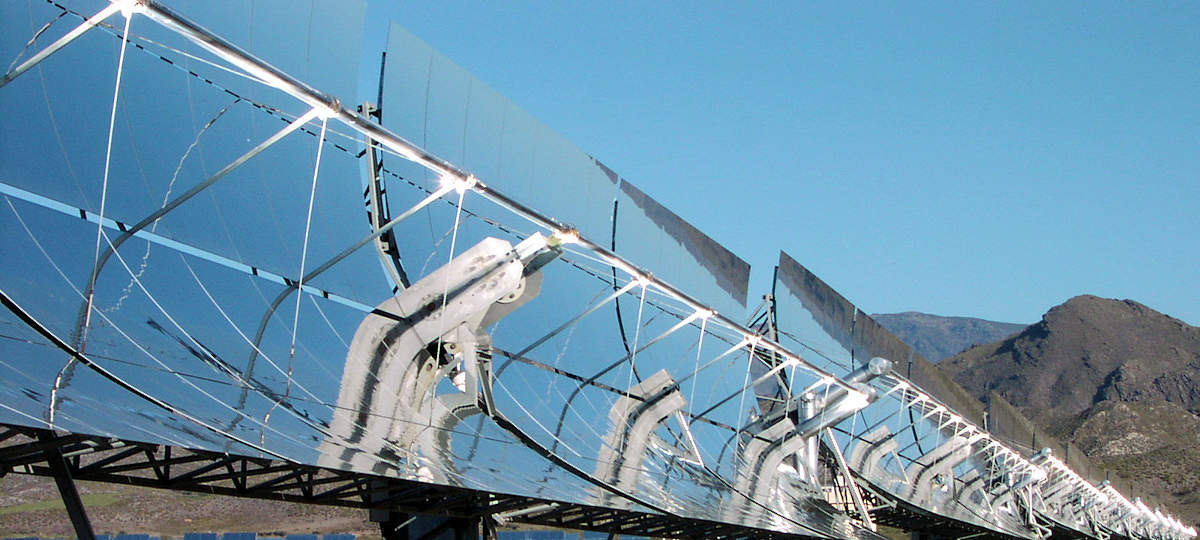
Solar thermal power plants
Many people associate solar electricity generation directly with photovoltaics and not with solar thermal power. Yet large, commercial, concentrating solar thermal power plants have been generating electricity at reasonable costs for more than 15 years. Volker Quaschning describes the basics of the most important types of solar thermal power plants.
Most techniques for generating electricity from heat need high
temperatures to achieve reasonable efficiencies. The output temperatures of
non-concentrating solar collectors are limited to temperatures below 200 °C.
Therefore, concentrating systems must be used to produce higher temperatures.
Due to their high costs, lenses and burning glasses are not usually used for
large-scale power plants, and more cost-effective alternatives are used,
including reflecting concentrators.
The reflector, which concentrates the sunlight to a focal line or focal point, has a
parabolic shape; such a reflector must always be tracked. In general terms, a
distinction can be made between one-axis and two-axis tracking: one-axis tracking
systems concentrate the sunlight onto an absorber tube in the focal line, while
two-axis tracking systems do so onto a relatively small absorber surface near the
focal point (see Figure 1).
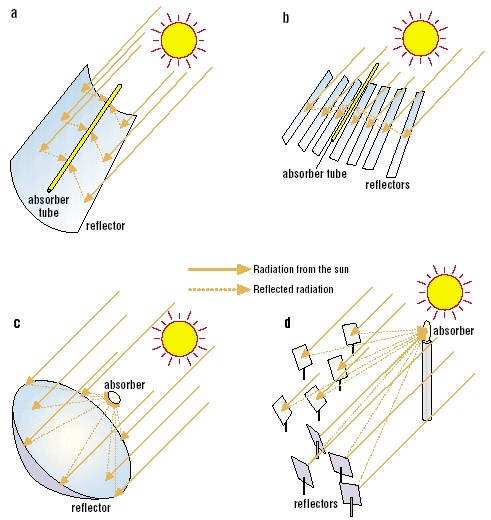
The theoretical maximum concentration factor is 46,211. It is finite because the
sun is not really a point radiation source. The maximum theoretical concentration
temperature that can be achieved is the sun’s surface temperature of
5500 °C; if the concentration ratio is lower, the maximum achievable temperature decreases.
However, real systems do not reach these theoretical maxima. This is because, on
the one hand, it is not possible to build an absolutely exact system, and on the other,
the technical systems which transport heat to the user also reduce the receiver
temperatures. If the heat transfer process stops, though, the receiver can reach
critically high temperatures.
Parabolic Trough Power Plants
Parabolic trough power plants are the only type of solar thermal power plant technology
with existing commercial operating systems until 2008. In capacity terms, 354 MWe of
electrical power are installed in California, and a plenty of new plants are currently in the
planning process in other locations.
The parabolic trough collector consists of large curved mirrors, which concentrate
the sunlight by a factor of 80 or more to a focal line. Parallel collectors build up a
300–600 metre long collector row, and a multitude of parallel rows form the solar
collector field. The one-axis tracked collectors follow the sun.
The collector field can also be formed from very long rows of parallel Fresnel
collectors. In the focal line of these is a metal absorber tube, which is usually
embedded in an evacuated glass tube that reduces heat losses. A special
high-temperature, resistive selective coating additionally reduces radiation heat
losses.
In the Californian systems, thermo oil flows through the absorber tube. This tube
heats up the oil to nearly 400 °C, and a heat exchanger transfers the heat of the
thermal oil to a water steam cycle (also called Rankine cycle). A feedwater pump
then puts the water under pressure. Finally, an economizer, vaporizer and
superheater together produce superheated steam. This steam expands in a two-stage
turbine; between the high-pressure and low-pressure parts of this turbine is a
reheater, which heats the steam again. The turbine itself drives an electrical generator
that converts the mechanical energy into electrical energy; the condenser behind
the turbine condenses the steam back to water, which closes the cycle at the
feedwater pump.
It is also possible to produce superheated steam directly using solar
collectors. This makes the thermo oil unnecessary, and also reduces costs
because the relatively expensive thermo oil and the heat exchangers are no longer
needed. However, direct solar steam generation is still in the prototype stage.
Guaranteed Capacity
In contrast to photovoltaic systems, solar thermal power plants can guarantee
capacity (see Figure 2). During periods of bad weather or during the night, a parallel,
fossil fuel burner can produce steam; this parallel burner can also be fired by
climate-compatible fuels such as biomass, or hydrogen produced by renewables.
With thermal storage, the solar thermal power plant can also generate electricity
even if there is no solar energy available.
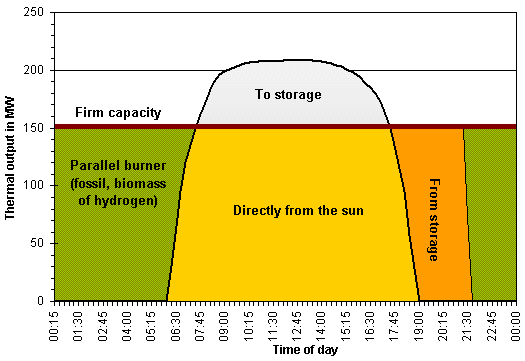
FIGURE 2. Typical output of a solar thermal power plant with two-hour thermal storage and backup heater to guarantee capacity
A proven form of storage system operates with two tanks. The storage medium for
high-temperature heat storage is molten salt. The excess heat of the solar
collector field heats up the molten salt, which is pumped from the cold to the hot
tank. If the solar collector field cannot produce enough heat to drive the turbine,
the molten salt is pumped back from the hot to the cold tank, and heats up the heat
transfer fluid. Figure 3 shows the principle of the parabolic trough power plant
with thermal storage.
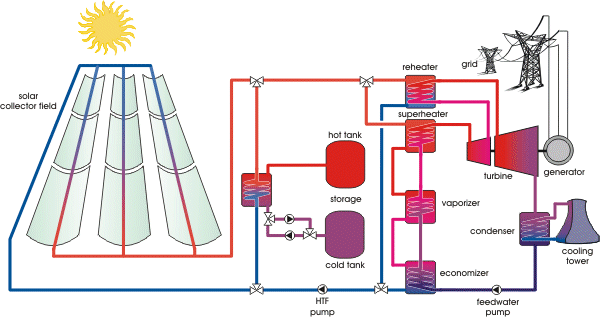
FIGURE 3. Schematic of a concentrated solar thermal trough power plant with thermal storage
Trough Power Plant Efficiencies
The efficiency of a solar thermal power plant is the product of the collector
efficiency, field efficiency and steam-cycle efficiency. The collector efficiency depends
on the angle of incidence of the sunlight and the temperature in the absorber tube,
and can reach values up to 75%. Field losses are usually below 10%. Altogether,
solar thermal trough power plants can reach annual efficiencies of about 15%;
the steam-cycle efficiency of about 35% has the most significant influence. Central
receiver systems such as solar thermal tower plants can reach higher
temperatures and therefore achieve higher efficiencies.
Solar Thermal Tower Power Plants
In solar thermal tower power plants, hundreds or even thousands of large
two-axis tracked mirrors are installed around a tower. These slightly curved
mirrors are also called heliostats; a computer calculates the ideal position for
each of these, and a motor drive moves them into the sun. The system must be
very precise in order to ensure that sunlight is really focused on the top of the
tower. It is here that the absorber is located, and this is heated up to
temperatures of 1000 °C or more. Hot air or molten salt then transports the heat
from the absorber to a steam generator; superheated water steam is produced
there, which drives a turbine and electrical generator, as described above for the
parabolic trough power plants. Only two types of solar tower concepts will be
described here in greater detail.
Open Volumetric Air Receiver Concept
The first type of solar tower is the open volumetric receiver concept (see
Figure 4a). A blower transports ambient air through the receiver, which is heated up
by the reflected sunlight. The receiver consists of wire mesh or ceramic or
metallic materials in a honeycomb structure, and air is drawn through this
and heated up to temperatures between 650 °C and 850 °C. On the front side, cold,
incoming air cools down the receiver surface. Therefore, the volumetric structure
produces the highest temperatures inside the receiver material, reducing the heat
radiation losses on the receiver surface. Next, the air reaches the heat boiler, where
steam is produced. A duct burner and thermal storage can also guarantee
capacity with this type of solar thermal power plant.
Pressurized Air Receiver Concept
The volumetric pressurized receiver concept (see Figure 4b) offers totally new
opportunities for solar thermal tower plants. A compressor pressurizes air to
about 15 bar; a transparent glass dome covers the receiver and separates the
absorber from the environment. Inside the pressurized receiver, the air is heated to
temperatures of up to 1100 °C, and the hot air drives a gas turbine. This turbine is
connected to the compressor and a generator that produces electricity. The
waste heat of the gas turbine goes to a heat boiler and in addition to this drives a
steam-cycle process. The combined gas and steam turbine process can reach
efficiencies of over 50 %, whereas the efficiency of a simple steam turbine cycle
is only 35 %. Therefore, solar system efficiencies of over 20 % are possible.
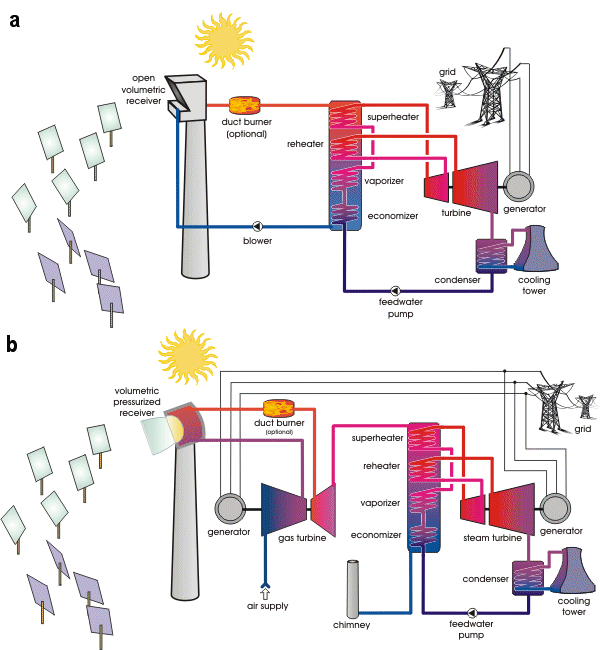
4. Schematic of two types of solar thermal tower power plant, showing (a) an open volumetric receiver with steam turbine cycle and (b) a pressurized receiver with combined gas and steam turbine cycle
Comparing Trough and Tower
In contrast to the parabolic trough power plants, no commercial tower power plant
exists at present. However, prototype systems – in Almería, Spain, in Barstow,
California, US, and in Rehovot, Israel – have proven the functionality of various
tower power plant concepts.
The minimum size of parabolic trough and solar tower power plants is in the
range of 10 MWe. Below this capacity, installation and O&M costs increase and
the system efficiency decreases so much that smaller systems cannot usually
operate economically. In terms of costs, the optimal system size is in the range of
50–200 MWe.
Dish-Stirling Systems
So-called Dish–Stirling systems can be used to generate electricity in the kilowatts
range. A parabolic concave mirror (the dish) concentrates sunlight; the two-axis
tracked mirror must follow the sun with a high degree of accuracy in order to
achieve high efficiencies. In the focus is a receiver which is heated up to 650 °C. The
absorbed heat drives a Stirling motor, which converts the heat into motive energy
and drives a generator to produce electricity. If sufficient sunlight is not
available, combustion heat from either fossil fuels or biofuels can also drive the
Stirling engine and generate electricity. The system efficiency of Dish–Stirling systems
can reach 20 % or more. Some Dish–Stirling system prototypes have been
successfully tested in a number of countries. However, the electricity
generation costs of these systems are much higher than those for trough or
tower power plants, and only series production can achieve further significant
cost reductions for Dish–Stirling systems.
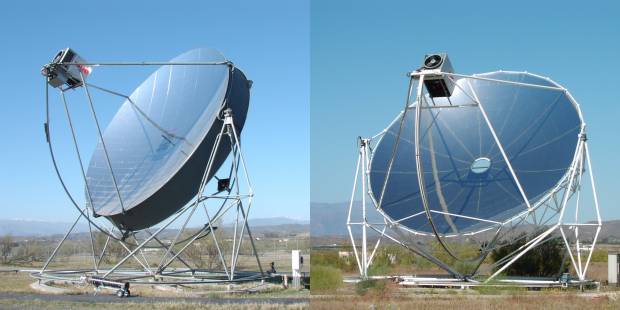
Dish-Stirling prototype systems in Spain
Solar Chimney Power Plants
All three technologies described above can only use direct normal irradiance.
However, another solar thermal power plant concept – the solar chimney power
plant – converts global irradiance into electricity. Since chimneys are often
associated negatively with exhaust gases, this concept is also known as the solar
power tower plant, although it is totally different from the tower concepts
described above. A solar chimney power plant has a high chimney (tower), with a
height of up to 1000 metres, and this is surrounded by a large collector roof, up to
130 metres in diameter, that consists of glass or resistive plastic supported on a
framework (see artist’s impression). Towards its centre, the roof
curves upwards to join the chimney, creating a funnel.
The sun heats up the ground and the air underneath the collector roof, and the
heated air follows the upward incline of the roof until it reaches the chimney. There, it
flows at high speed through the chimney and drives wind generators at its bottom.
The ground under the collector roof behaves as a storage medium, and can
even heat up the air for a significant time after sunset. The efficiency of the solar
chimney power plant is below 2 %, and depends mainly on the height of the tower,
and so these power plants can only be constructed on land which is very cheap
or free. Such areas are usually situated in desert regions.
However, the whole power plant is not without other uses, as the outer area
under the collector roof can also be utilized as a greenhouse for agricultural
purposes. As with trough and tower plants, the minimum economical size of
solar chimney power plants is also in the multi-megawatt range.
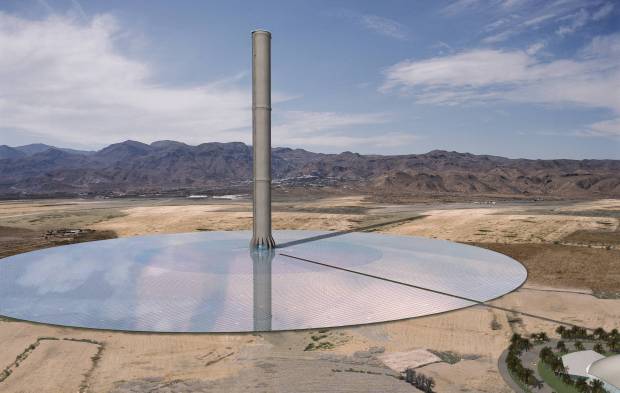
Artist’s impression of a 5 MW solar chimney power plant SCHLAICH BERGERMANN SOLAR (SBS) GMBH, STUTTGART www.sbp.de
Electricity Generation Costs
Due to the poor part-load behaviour of solar thermal power, plants should be
installed in regions with a minimum of around 2000 full-load hours. This is the
case in regions with a direct normal irradiance of more than 2000 kWh/m2
or a global irradiance of more than 1800 kWh/m2. These irradiance values can
be found in the earth’s sunbelt; however, thermal storage can increase the number
of full-load hours significantly.
The specific system costs are between €2000/kW and €5000/kW depending on the system size,
system concept and storage size. Hence, a 50 MWe solar thermal power plant will
cost €100–250 million. At very good sites, today’s solar thermal power plants can
generate electricity in the range of €0.15/kWh, and series production could
soon bring down these costs below €0.10/kWh.
The potential for solar thermal power plants is enormous: for instance, about 1 % of the area of the
Sahara desert covered with solar thermal power plants would theoretically be
sufficient to meet the entire global electricity
demand. Therefore, solar thermal power systems will hopefully play an important
role in the world’s future electricity supply.